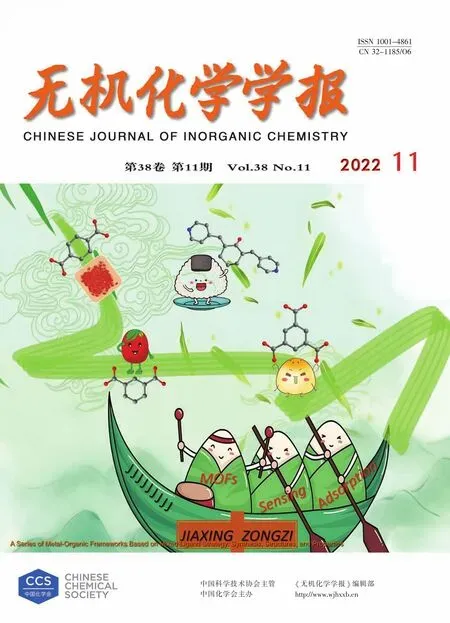吡啶-2-甲醛肟钛氧簇合物的合成、结构调控及光电性质
郁有祝 张艳茹 郭玉华 周忠源 杨立国 李嘉琳 方黎月 乔宽宽
(1安阳工学院化学与环境工程学院,安阳 455000)
(2山西师范大学化学与材料科学学院,太原 030000)
0 Introduction
As a representative semiconductor material,titanium dioxide(TiO2)is widely applied in many areas such as catalysis,energy,and environmental science owing to its high stability,negligible toxicity,and cheap cost[1-4].Doping TiO2materials with nitrogen is an effective approach to modify the band-gap energies and strengthen efficiencies for their photocatalytic applications[5-8].However,the photocatalytic mechanisms of nitrogen-doped TiO2(N-TiO2)materials could not be illustrated clearly due to their imprecise and inhomogeneous characteristics.As the structure and reactivity models of N-TiO2,nitrogen-doped titanium oxo clusters(N-TOCs) have attracted considerable attention because of their accurate atomic structures[9-12].In general,N-TOCs are characterized by N—Ti bond which always exhibits high photocatalytic activity such as photocatalytic H2evolution[12-13],and rapid dye degradation[9,14].To date,it is still of great importance to enlarge the numbers and structure diversities of NTOCs for future potential applications.
As is known,the construction of N—Ti bonds is crucial for N-TOCs.The N-donor ligands with the type of N(sp2)atoms such as pyridine,1,10-phenanthroline,and pyrazole have good affinities to Ti(Ⅳ)ions,and a few N-TOCs have been reported[9,12].To be noted,despite including N—Ti bonds in the N-TOCs their light absorption is mainly located in the ultraviolet region,limiting their full use of sunlight[9,13].Introducing dye-ligands has proven to be an effective strategy for the construction of N-TOCs with narrow band gaps[15-18].However,simultaneously use of N-donor ligands and dye-ligands in one reaction system for N-TOCs construction is not beneficial for obtaining diverse structures of N-TOCs because of the rigidity and steric hindrance of ligands.In this context,selecting one type ligand both including N(sp2)and N(sp2)—O-as N-donor and dye-ligand for N-TOCs construction and at the same time introducing the second ligand to regulate the structures is appealing,which is seldom reported in the literature.Accordingly,2-pyridinecarbaldehyde oxime(HPycox)characterized with N(sp2)and N(sp2)—O-as coordinated sites is the ideal N-donor and dye-ligand for N-TOCs construction,and phosphonic acid with strong coordination ability towards Ti4+ions can be used as ligands to regulate core structures of N-TOCs.
Based on the above-described background,HPycox was used as N-donor and dye-ligand in this work to construct N-TOCs,and simultaneously phosphonic acid was introduced to regulate the core structures of N-TOCs.As shown in Scheme 1,we solvothermally synthesized three N-TOCs formulated as[Ti2(μ2-O)(Pycox)2(OiPr)4](1),[Ti3(μ2-O)2(Pycox)2(Ph2PO2)2(OiPr)4](2)and[Ti6(μ2-O)2(μ3-O)2(Pycox)2(PhPO3)4(OiPr)6]·2CH3CN (3)respectively.All the structures were characterized by X-ray single crystal diffraction.Moreover,their light absorption behaviors,band gaps,and photocurrent responses were also investigated.
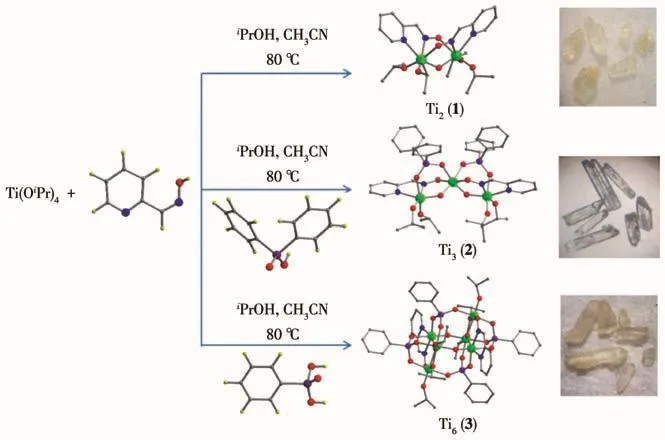
Scheme 1 Illustration of the synthesis of complexes 1-3
1 Experimental
1.1 Material and methods
All starting reagents were of AR grade and used as received without further purification.IR spectra were performed with a Perkin Elmer Spectrum 100 FT-IR Spectrometer.The powder X-ray diffraction(PXRD)patterns were obtained at 40 kV and 100 mA on a Rigaku D/Max-2500 diffractometer from 5°to 50°,with the use of Cu Kα radiation(λ =0.154 2 nm)at room temperature.The solid-state UV-Vis diffuse reflectance spectra of complexes 1-3 were recorded on a TU-1901 spectrophotometer and scanned in a range of 240-800 nm.The electrochemical measurements were carried out using CHI 660E as the electrochemical work station in an ambient environment in a standard three-electrode system.The sample coated ITO glass was used as the working electrode,and a Pt plate and an Ag/AgCl electrode were used as the auxiliary electrode and the reference electrode respectively.An aqueous solution of Na2SO4(0.2 mol·L-1)was used as an electrolyte.The working electrodes were prepared as the reference reported[15,19-20].A 300 W xenon lamp was used as a full-wavelength light source for photocurrent measurement,located 20 cm away from the surface of the ITO electrode with an applied potential of 0.6 V.The on-off cycling irradiation interval was 10 s.
1.2 Synthesis of complex 1
First,HPycox(1 mmol,122.13 mg)was added with stirring to 1 mL isopropanol and 6 mL acetonitrile.After 10 min,Ti(OiPr)4(1.63 mmol,0.5 mL)was added to the above solution with vigorous stirring,and then the resulting mixture was sealed in a Teflon-lined stainless vessel(10 mL)and heated at 80℃for 72 h under autogenous pressure.The vessel was then cooled by air to room temperature spontaneously.Light yellow block crystals were obtained and then washed thoroughly with acetonitrile.Yield:0.156 g(53% based on HPycox).Elemental analysis Calcd.(Found)for C24H38N4O7Ti2(%):C,48.83(48.67);H,6.49(6.53),N,9.49(9.42).IR(KBr pellet,cm-1):3 067(w),2 970(s),2 851(w),2 956(w),1 606(s),1 541(m),1 476(s),1 346(w),1 129(s),1 000(s),783(m),697(s),600(s).
1.3 Synthesis of complex 2
A mixture of HPycox(1 mmol,122.13 mg)and diphenylphosphinic acid(0.5 mmol,109 mg)was added with stirring to 1 mL isopropanol and 6 mL acetonitrile.After 10 min,Ti(OiPr)4(1.63 mmol,0.5 mL)was added to the above solution with vigorous stirring,and then the resulting mixture was sealed in a Teflon-lined stainless vessel(10 mL)and heated at 80℃for 72 h under autogenous pressure.The vessel was then cooled by air to room temperature spontaneously.Light yellow block crystals were obtained and then washed thoroughly with acetonitrile.Yield:0.152 g(56% based on diphenylphosphinic acid).Elemental analysis Calcd.(Found)for C48H58N4O12P2Ti3(%):C,52.96(52.79);H,5.37(5.28);N,5.15(4.98).IR(KBr pellet,cm-1):3 058(w),2 960(m),2 921(w),2 849(w),1 604(m),1 551(w),1 440(m),1 132(s),995(s),687(m),556(s).
1.4 Synthesis of complex 3
A mixture of HPycox(1 mmol,122.13 mg)and phenylphosphonic acid(0.5 mmol,80 mg)was added with stirring to 1 mL isopropanol and 6 mL acetonitrile.After 10 min,Ti(OiPr)4(1.63 mmol,0.5 mL)was added to the above solution with vigorous stirring,and then the resulting mixture was sealed in a Teflon-lined stainless vessel(10 mL)and heated at 80℃for 72 h under autogenous pressure.The vessel was then cooled by air to room temperature spontaneously.Light yellow block crystals were obtained and then washed thoroughly with acetonitrile.Yield:0.093 g(45% based on phenylphosphonic acid).Elemental analysis Calcd.(Found)for C58H78N6O24P4Ti6(%):C,42.11(42.23);H,4.75(4.62);N,5.08(4.96).IR(KBr pellet,cm-1):3 066(w),2 968(m),2 916(w),2 871(w),1 603(m),1 548(m),1 475(m),1 101(s),1 003(s),788(m),698(m),583(s).
1.5 X-ray structure determination
Crystallographic data of 1 and 2 were collected on a Bruker SMART APEX Ⅱ diffractometer equipped with a graphite-monochromatized Mo Kα radiation(λ=0.071 073 nm)at room temperature.Crystallographic data of 3 was collected on an Agilent Gemini Eos diffractometer equipped with a graphite-monochromatized Mo Kα radiation(λ=0.071 073 nm).All the structures were solved by direct methods and refined by using the SHELXTL-2014.The relatively large residual peaks in the structure of complex 2 were located near the carbon atoms of isopropoxide groups which mainly resulted from the disordered carbon atoms.Relevant crystallographic data are summarized in Table 1.The selected bond lengths and bond angles are given in Table 2.
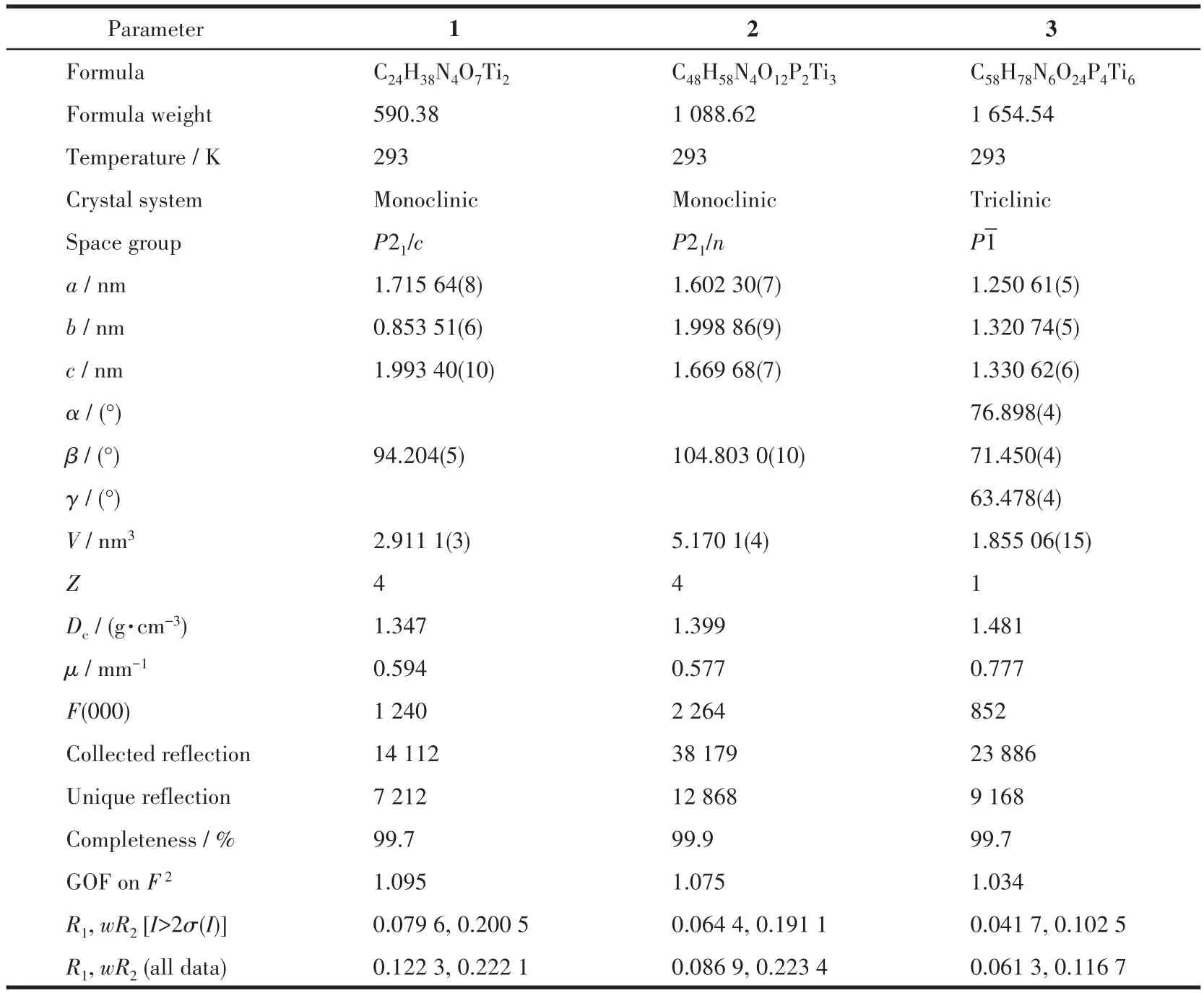
Table 1 Selected crystallographic data for complexes 1-3
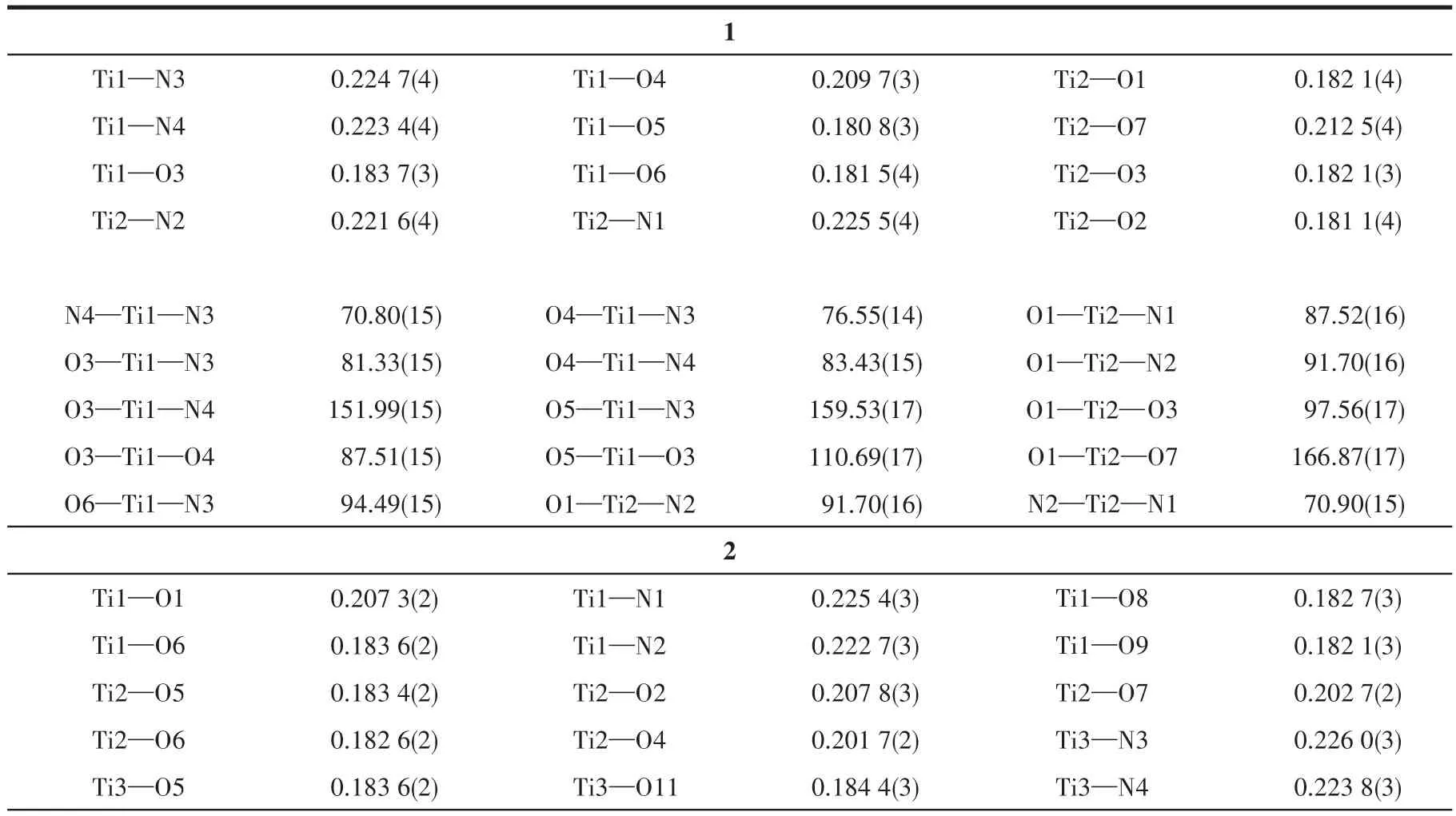
Table 2 Selected bond lengths(nm)and angles(°)for complexes 1-3
CCDC:2149944,1;2149949,2;2149950,3.
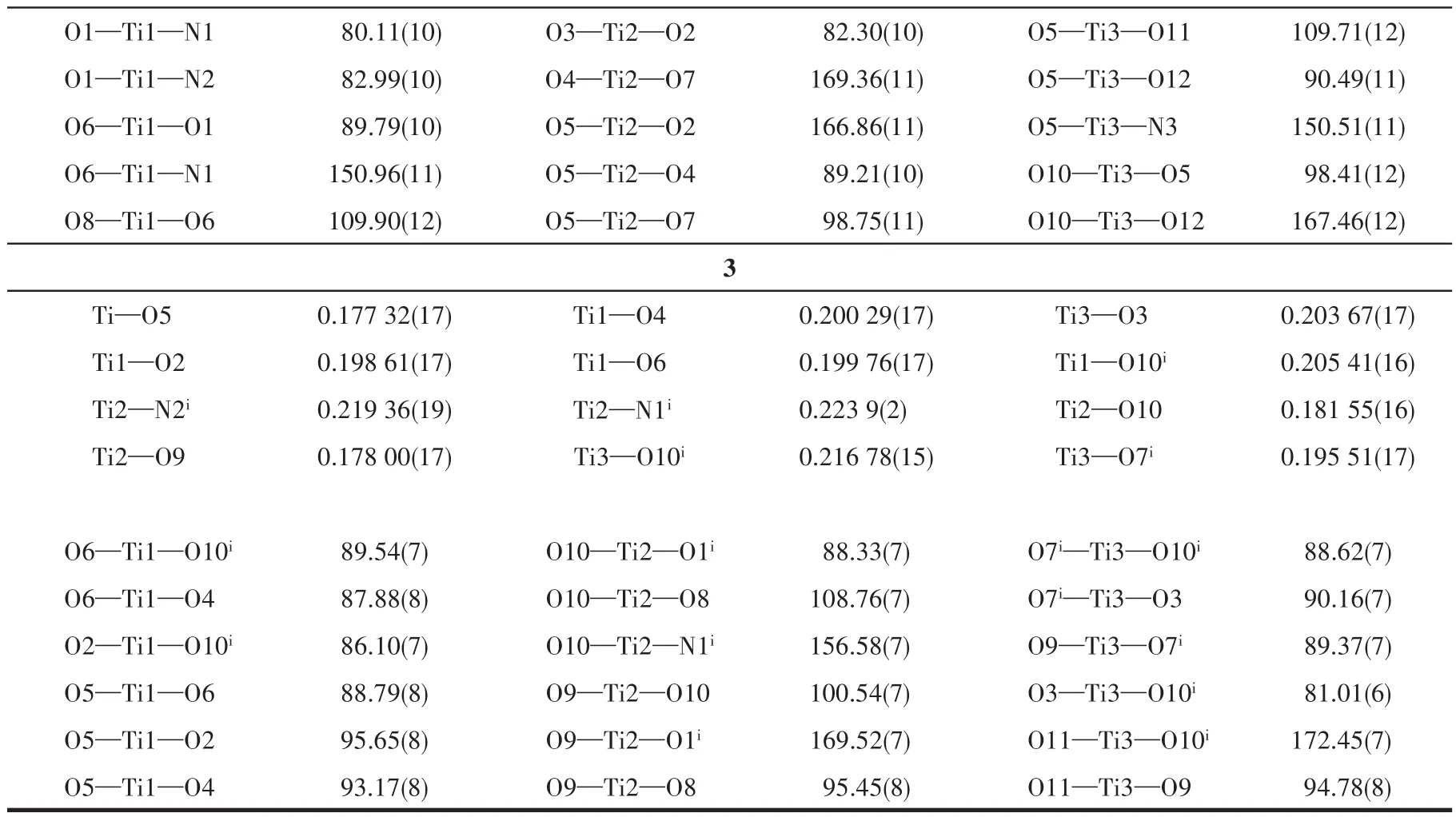
Continued Table 2
2 Results and discussion
2.1 Synthesis
In the synthetic progress,we firstly synthesized complex 1 in a simple and general approach.Structure analysis of 1 showed that only two Ti atoms,two Pycoxanions,and four isopropoxide groups are observed in the structure.Notably,though the structure of complex 1 is nearly the same as the reported TOC except for the solvent molecular,the synthetic method of complex 1 in this work is easier than the reported one[21].The simple structure of 1 indicates that the structure may be regulated by a stronger ligand.Then,in the same synthetic system of 1,diphenylphosphinic acid was added to regulate the structure,resulting in the titanium numbers tuned from two of 1 to three of 2.Obviously,the regulation of titanium numbers from two to three was only in a small range due to the large steric resistance of diphenylphosphinic acid. Further, we chose phenylphosphonic acid with smaller steric resistance to replace diphenylphosphinic acid under the same condition,and very interestingly the titanium numbers are tuned from three of 2 to six of 3.The successful structure regulation of TOCs in this work indicates that phosphonic acid with different steric resistance can be used to regulate TOCs structures,which may provide us with more TOCs with different structure diversities in the future.
2.2 Structure description of complex 1
The molecular structure of complex 1 consists of two Ti4+ions,one μ2-O ion,two Pycox-anions,and four isopropoxide groups(Fig.1a).The two Ti4+ions show the same octahedral[TiO4N2]coordination environments which linked by vertex-sharing mode to form a Ti2core(Fig.1b).The packing structure demonstrates the shortest distance of the adjacent clusters in 1 is 0.69 nm(Fig.1c).

Fig.1 Crystal structure(a),polyhedral view(b),and packing diagram(c)for complex 1
2.3 Structure description of complex 2
The molecular structure of complex 2 consists of three Ti4+ions,two μ2-O ions,two Pycox-anions,two diphenylphosphonate molecules,and four isopropoxide groups(Fig.2a).Among the three Ti4+ions,two Ti4+ions show the same octahedral[TiO4N2]coordination environments,while the other Ti4+ions show[TiO6]coordination environments.The three Ti4+ions are linked by vertex-sharing mode to form a Ti3core(Fig.2b).The packing structure demonstrates the shortest distance of the adjacent clusters in 2 is 0.765 nm(Fig.2c).

Fig.2 Crystal structure(a),polyhedral view(b),and packing diagram(c)for complex 2
2.4 Structure description of complex 3
The asymmetric unit of complex 3 consists of three Ti4+ions,two O2-ions,one Pycox-anion,two phenyl phosphonate molecules,three isopropoxide groups,and one CHCN.Among the six Ti4+ions,four Ti4+ions show octahedral[TiO6]coordination environments,while the other two Ti4+ions show[TiO4N2]coordination environments(Fig.3a).Fig.3b illustrates that three Ti4+ions by edge and vertex-sharing modes respectively,in turn,generate a nearly flat type Ti3O subunit,then the two same Ti3O subunits are linked by two μ2-O atoms to form a Ti6core structure by vertex-sharing mode(Fig.3b).The packing structure demonstrates the shortest distance of the adjacent clusters in 3 is 1.25 nm(Fig.3c).Interestingly,the structure of complex 3 is very similar to our early reported Ti6oxo cluster despite their different dye-ligands in the structures.

Fig.3 Crystal structure(a),polyhedral view(b),and packing diagram(c)for complex 3
The bond lengths of Ti—O in complexes 1-3 are in a range of 0.180 8-0.212 5 nm,0.181 0-0.207 3 nm,0.177 3-0.205 4 nm,respectively,and the Ti—N bond lengths in complexes 1-3 are in a range of 0.221 6-0.225 5 nm,0.222 7-0.226 0 nm,0.216 8-0.223 9 nm,respectively.Both the Ti—O and Ti—N bond lengths are consistent with those in the literature[19,22-28].
2.5 PXRD analysis
The phase purity for complexes 1-3 was determined by PXRD at room temperature.As shown in Fig.4,all the simulated patterns from the single-crystal X-ray data of 1-3 were in good agreement with the experimental ones,indicating the pure phase of complexes 1-3.Notably,the intensities difference between the simulated and experimental patterns can be ascribed to the powder size and variation in preferred orientation during experimental PXRD data collections[29].

Fig.4 XRD patterns of complexes 1-3
2.6 Light absorption,band gap,and photocurrent property
The band gaps of complexes 1-3 were determined by a UV-Vis diffuse reflectance measurement method at room temperature.As shown in Fig.5a,solid-state optical absorbance spectra indicate that complexes 1 and 3 showed nearly the same absorption behaviors in a range from 240 to 500 nm.In contrast,complex 2 only exhibited light absorption in a range of 240 to 400 nm.On the basis of the Kubelka-Munk function[31],the optical band gaps of complexes 1-3 were estimated to be 2.89,3.00,and 2.87 eV,respectively(Fig.5b),showing an obvious reduction compared to the band gap(3.2 eV)of TiO2.The relatively narrow band gaps of complexes 1-3 can be attributed to the Pycox-as dyeligand in structures.In addition,photocurrent responses of complexes 1-3 were measured by using a typical three-electrode photoelectrochemical cell in a 0.20 mol·L-1Na2SO4electrolyte solution under 0.6 V bias potential.As shown in Fig.5c,upon illumination,the photocurrents were quickly generated,while when the light was switched off,the photocurrents rapidly decayed.Complexes 1 and 3 showed smaller photocurrent densities of 0.02 and 0.01 µA·cm-2,respectively,while complex 2 exhibited a higher photocurrent density of 0.10µA·cm-2.The different photocurrent responses of complexes 1-3 might be ascribed to the different rigidity and hydrophobicity of ligands in the structures.

Fig.5 Solid-state UV-Vis reflectance spectra(a),band gaps(b),and photocurrent responses(c)of complexes 1-3
2.7 Mott-Schottky measurements
Similar to N-TiO2,N-TOCs also have semiconductor properties.In this work,the LUMO positions of complexes 1-3 were conducted by Mott-Schottky measurements at frequencies of 300,500,and 1 000 Hz.As shown in Fig.6,the LUMO position value of 1 was-0.85 eV,while the LUMO positions of 2 and 3 were similar with the value of-0.80 eV.The negative LUMO position values of 1-3 indicate their potential applications for photocatalytic reductions,such as for reduction of CO2to CO,and as well for photocatalytic H2evolution[31-33].

Fig.6 Mott-Schottky plots for 1(a),2(b),and 3(c)in 0.2 mol·L-1Na2SO4 aqueous solution
3 Conclusions
In summary,using HPycox as a dye-ligand,we successfully synthesized three N-TOCs with various core structures.Structure analysis of complexes 1-3 reveals that phosphonic acids are the ideal ligands for their structural regulation.Moreover,the light absorption behaviors,band gaps,and photocurrent responses are also influenced by the titanium oxo cores and the ligands.All of them have potential applications for photocatalytic reductions,and further studies of photocatalytic applications are underway.

